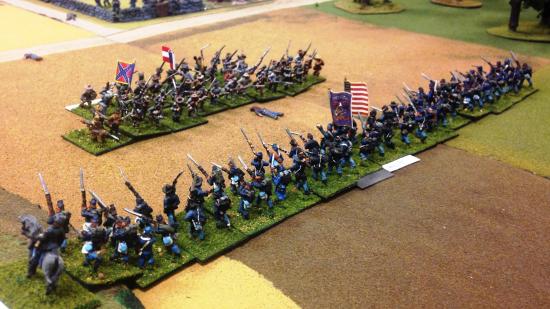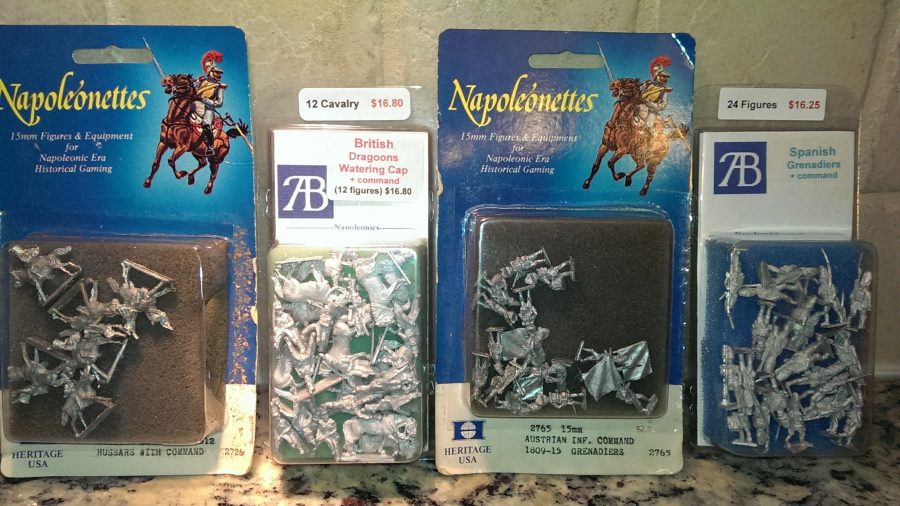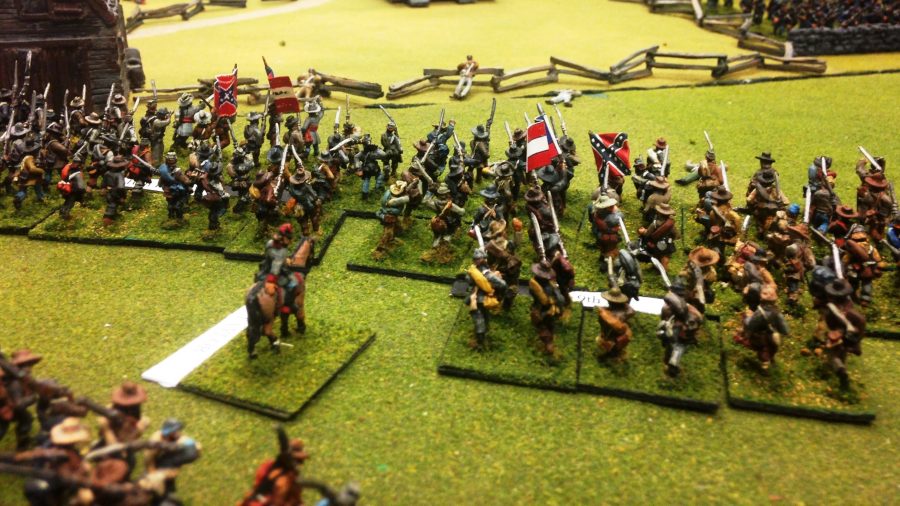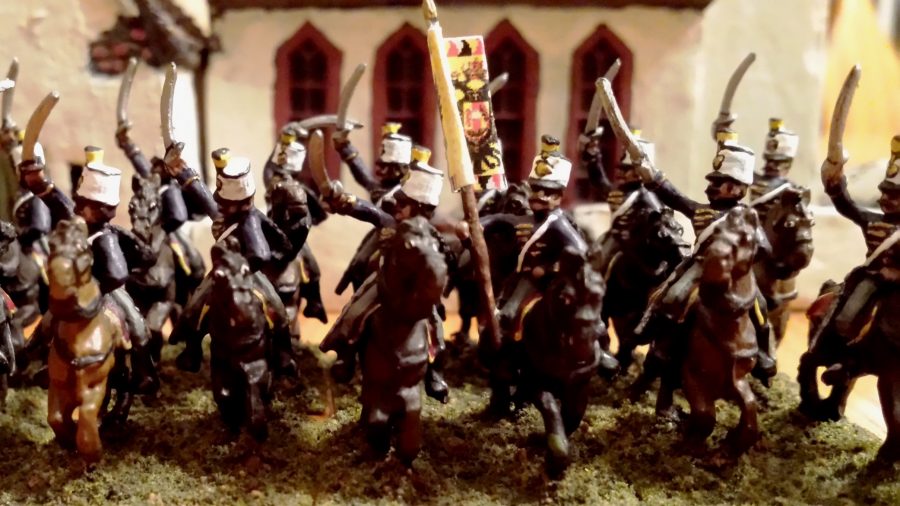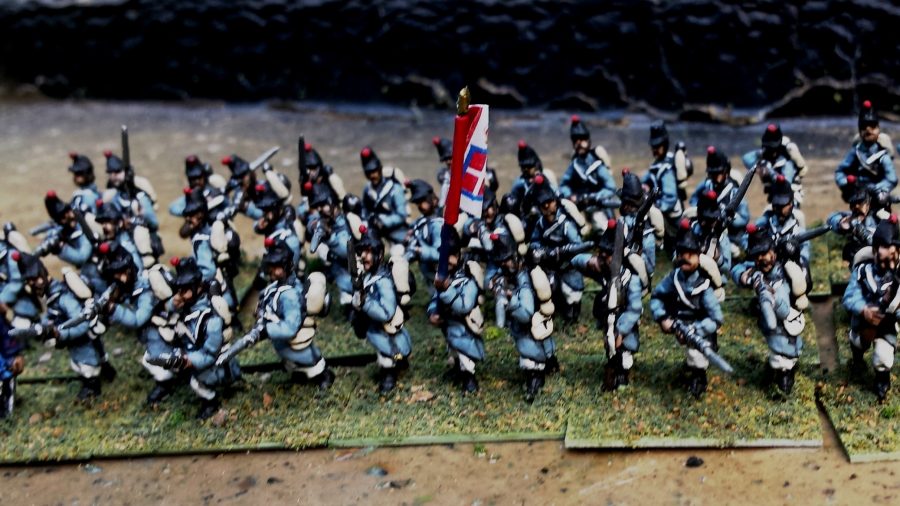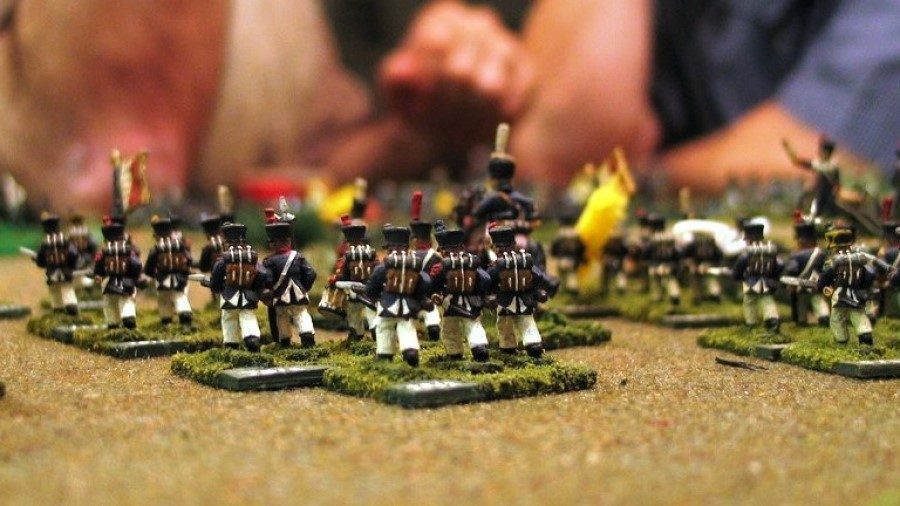Anybody remember the old Taco Bell television commercials, the one with the little chihuahua who with small box, string and stick went searching to catch Godzilla speaking “Here, lizard, lizard, lizard.” Then the big guy trumps around the corner and the diminutive pup bats not a lash, but mutters, “Whoa, I think I need a bigger box.” In many ways I think the evolution of 15 mm tabletop gaming reminds me of that. OK, gimme a chance here – read on and hopefully you’ll see what I’m getting at.
During a previous HMGS convention I strolled through the flea market and wound up buying 54 packs of vintage Heritage 15 mm Napoleonettes. By 15mm I mean that the height of an average soldier from bottom of shoe to top of head was 15mm. The Napoleonette series has not been produced in years and these are now considered vintage collectibles.
What was $2.95 for a pack of eight cavalry now goes for $24.95 at vendors such as Noble Knight Games, which just advertised receiving a restock given he had sold out. Again. Looking at these figures I could not help but notice how small they looked, and on the table they have actually been mistaken for 10mm by the casual observer. That’s when it hit me as to how much this part of the tabletop hobby had changed, and not necessarily for the good.
Let me explain…
In the beginning, Napoleonic – which stood as the second most popular tabletop period after World War II – was exclusively played with 25mm figures. Each figure on the table represented 20 troops, and rules were very complex, as in the player had to select the specific ammunition cannon would fire on a gun by gun basis. Given that Britain was the hobby’s center of the universe, housing constraints meant small battles or skirmishes that used a point system to produce armies that would give an accurate feel for the period, but not necessarily historical armies.
Thus a French player might be able to spend some of his 1200 army points on a regiment of Cuirassiers, a form of armored heavy horse. The problem was that a regiment of Cuirassiers never existed. Outside the 14th Century in Spain, when the French used Cuirassiers, they never used a regiment, or a brigade or even a division. No, Napoleon liked to throw entire corps of these heavies at the enemy, and this means at least eight regiments of these behemoths, plus one or two more of lancers in 1812. But tabletop battles were just too small to justify the points necessary for purchase and few homes had a table big enough. From an historical perspective, you needed to re-fight entire battles with a good 60,000 per side. It was pretty much the same thing with massed artillery where 160 guns might be drawn from multiple corps and divisions. Again, entire battles needed to be replicated. In short, many of the battlefield systems and processes that made the Napoleonic Wars “Napoleonic” could not be played using the systems available.
There were some easy fixes to this of course, and one was simply an increase in scale. The old 1:20 ratio became 1:60 with the introduction of Scott Bowden’s EMPIRE in the Colonies, and battalions became 12 figures strong vice the old 36. Today the ratio is often 1:100 or 1:120 and battalions have been discarded in favor of brigades.
The most lasting solution, however, was popularized by Britain’s Miniature Figurines Ltd, or Minifigs as it is affectionately known. They staked a claim on figures 15mm high vice 25, a 40% reduction in size. Initially quality suffered as the lack of detail made them look like little gnomes with shakos. Sold on strips and dirt cheap, they did paint up nice however and allowed for the play of big battles. In the United States, Heritage introduced their Napoleonette (and later Confederette series for the American Civil War) product line. The models were superbly sculpted and exquisitely detailed, to the point where horses were actually designed with different sizes depending upon their classification. Light cavalry had the smallest mounts (and British lights actually had bobtails), next dragoons, then heavy cavalry and last but not least, guard units such as Napoleon’s Grenadiers a Cheval with very large castings.
Form square (eyes): These are the very best Napoleonic games
Unfortunately selection was limited and when the sculptor passed on, additions to the line were simply poorly designed heads grafted on to existing bodies. Otherwise one had to make do with 1815 French from the Waterloo campaign or 1813 Prussians and Austrians, followed closely by 1812 Russians. If you wanted to throw together an 1806 Prussian army, resplendent in their Frederickan style bicorns, you pretty much were out of luck. For those who got their start in the hobby with this figure line, you will undoubtedly remember how many client state armies you could build using French figures. I swear the French Carabinier a Cheval set had to be the most widely used as it could serve as Saxon, Westphalian Guard and Lord knows what else. Given the fact that riders were molded directly onto the horses and flags and lances molded into the figure, these little wonders were very sturdy.
And the concept worked, certainly here across the pond. Minifigs redid their line not once but several times to introduce more detail, though retaining the smoother more subtle sculpting style of Heritage and their own earlier efforts. More companies joined the party, notably Old Glory (now Old Glory 15s/19th Century Miniatures) who used a rougher, more pronounced sculpting style to accentuate details such as straps or clothing folds. The company also introduced retail packaging that increased the number of figures per purchase. In the Mother Country, 15mm figures were often sold with 8 infantry a pack, and are still sold that way today. Heritage plopped in 24 figures, partially in support of EMPIRE as 24 was the exact number needed for two battalions. Today Old Glory 15s are sold 50 infantry to a pack, pushing the envelope even further.
Variety also increased. First, there was no need to fake it by using French for Saxon or whatever. Napoleonics now had complete lists for everyone that participated, countries like Denmark, Sweden, Hessen Darmstadt and Bavaria. Within each country variety existed as well. Prussian ranges expanded to include the doomed army of 1806 while the Russian army continued with not only the popular 1812 Borodino army, but also the 1807 army which collapsed at Friedland and the bicorned 1799 army that marched through Italy with Marshal Suvarov.
Saxons not only had legitimate heavy cavalry, but individual and distinct models representing the Garde du Korps and the Regiment von Zastrow which left its armor behind as it advanced towards Moscow. There was now French infantry in bicorne, others in the 1812 regulation Barden garb and others still in campaign dress to include overcoat, overalls and oil skin shako covers. Instead of a single pose, multiple offerings were provided. Old Glory Austrians had a march-attack pose that included some soldiers at right shoulder arms, some at left, some at marching salute, some with musket and shako held high, wounded and sergeants urging their men forward.
In effect, the 15mm concept, whether for Napoleonics, American Civil War or whatever, had accomplished its mission. Its smaller size became an integral part of making entire battles playable on the tabletop. Additionally, the level of detail had advanced so dramatically that it rivaled even the best 25mm products on the market. From younger partner, the scale had metaphorically grown up.
The problem was that this new status wasn’t a metaphor. The scale actually, physically did grow up. Seriously, not joking here. As in the figures actually got bigger and taller.
Flags and smoke: These are the best American Civil War games
One of the big figure lines on the market became Australia’s AB Miniatures, with figures initially described as “large 15s.” The figures are super detailed but actually 18 mm tall. Yes, 25s have grown to 28 mm, but that’s a 12 % height increase vice a 20 % increase for 15mm, and now someone has introduced a new 20mm.
Aesthetically, combining true 15s like Napoleonettes with ABs kinda looks like an army made up of Aragorn with a side of Rangers alongside Gimli and a horde of dwarves (Misty Mountain Clan of course). Given that miniatures are perhaps THE most visual of wargaming genres, this matters bigtime to a bunch of people. It just plain looks weird when a Prussian soldier in Shirmutz cap is taller than the 8 foot door of the building he’s defending.
But oddly enough, that’s not the important issue. As trivial as it may seem, having to mount these new figures on movement stands is a big problem. This problem stems from the fact that base sizes are rules driven to replicate to scale actual formation widths and depths on the tabletop. In some case it’s very difficult to get 18mm to fit on a stand without breaking the serried ranks of bayonets look most desire. You often have to shift the officer so he can shave his young drummer using his sword as a straight razor. In some cases the new figures simply will not fit, especially with artillery stands. Brigade level games where one inch equals 120 yards, necessitates gun stands that are both narrow and shallow. Many of the new artillery pieces take up so much room that the trail hangs off the back, the wheels drop off the left or right edge and no room is left for the gunners.
The easy solution of making the stands larger won’t work as it throws the scale off, and many an engagement has turned on whether a dragoon regiment can just make contact or a unit is just in or out of artillery range. Making the board larger to account for the increase is also an option, but this would seem to defeat the very purpose 15 mils were created in the first place – small but detailed figures to allow entire battles to be played, not point-driven skirmishes. In many situations it really won’t matter, but it might if the trend towards larger sizes continues. No one knows for sure, of course, but as noted above, a new 20mm scale is hitting the streets even as I type.
Cynics would say the size increase is an economics drive because 20 % larger figures means 20 % more pewter that someone has to pay for. Perhaps, but from what I see we are talking about nothing more than making the figures as detailed as possible while making them as easy to paint as possible. I respect that. If I can remember Minifigs on a strip, that pretty well means I’m a… ‘mature’ (yeah, that’s a good word) gamer and thus possess eyes not as sharp as they once were, hands not as steady with perhaps arthritis right around the corner. So I really get and appreciate the thought, though I remain unsure it’s worth it.
Right now my prognostication tells me this trend will indeed continue, at least here in the States. I just see too many advertisements for 20s popping up right now, mostly moderns but there seems to a hand scribbling on a wall somewhere. This means all of us true 15 mil aficionados as simply going to have to adjust, become REAL good at figure placement and generally suck it up.
The one thing I would not do is try to retool any rules to account for the larger size. I’ve actually tried that and the amount of confusion caused really wasn’t worth it. Instead, if a stand calls for four figures mounted, adjust or simply use three. And while I thought that mixing types was no big deal, the 10mm Napoleonettes comments still resonate, so I try to avoid that if possible. What this actually means is that I am now replacing my collection with larger ABs, basically throwing in the towel, my Flea Market purchase notwithstanding. Alas at $2.00 US a Napoleonette box, my resistance fell like lemmings walking off a cliff.
Yet there is at least a small glimmer of hope for an alternative. Just as 20mm gaming is being introduced, so is 12mm gaming, a step up from 10’s providing the little more heft and detail most gamers crave. I spoke with one of the sculptors recently and he admitted they were really “large 12s” and actually about 13.5mm in height. I smiled and recalled my purchase of Heritage true 15s, thinking “Damn, I’m good.”
This article was originally published in November 2016.
